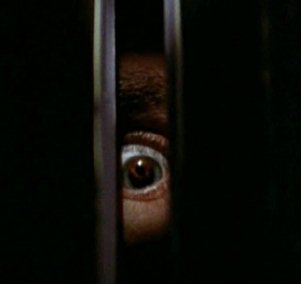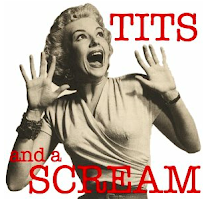In a previous post on this blog, Looking through Gary Gilmore's Eyes, I discussed the fairly widespread use of what has been called the I-camera; that is, when a scene is being filmed as if through the eyes of one character, to let the audience see just what that specific character is seeing. In horror films, it is inevitably the villain's eyes through which we are invited to look. I argued against the idea of I-camera as forced identification and linked it rather with the Derridean idea of horror in seeing yourself seen.
Upon watching Black Christmas (1974) for the first time quite recently, it struck me how much more meaning there lies in the act of watching, and the knowledge that you are being watched, in horror films.
The use of I-camera or "forced identification" probably goes further than just pointing out how essentially different the "evil" character is to normal people. The fact that it is always someone watching from the outside as seemingly normal people engage in completely normal, everyday activities – before this character ends up killing them all, or at least trying to – is a way of demonising difference. Once the quality of "difference" is marked as truly monstrous, it is not a terribly long way away to judge those who are different as equally horrible.
In the excellent collection of essays on horror films and gender, The Dread of Difference, editor Barry Keith Grant writes in his introduction:
In 1986 Constance Penley wrote that "science fiction film as a genre –– along with its evil twin, the horror film –– is now more hyperbolically concerned than ever with the question of difference". Certainly she is correct in her observation about the genre's concerns, although her use of the temporal qualifier ("now") is perhaps somewhat misleading, for such treatment has tended to characterize the genre throughout its history.
I think that this goes further than just being limited to gender issues, although that is what Grant (and normally myself) is preoccupied with. If that's where it stopped, Black Christmas would simply be about a group of sorority girls who are afraid of one man. While it would be useless to claim that that outline is not part of what is happening (plot: a group of sorority girls are being stalked and slashed, one by one, by an unknown man), it is a lot more interesting to think in broader terms with this one. It is the fact that someone is watching from the outside that is the source of the horror in this film, as in countless others. Someone who is not like "us" (that is, the sorority girls or whatever group of mostly average people we are meant to sympathise with in any given slasher film), and who can only ever hope to watch from the outside as we carry on with our normal, somewhat dull, activities.
I struggle to think of any kind of successful film plot in which some kind of irreconcilable difference does not play an essential part; and it's no wonder, because what conflicts would there be without difference? And could an interesting story ever be told without some kind of conflict in the core? Possibly not. That does not mean, however, that the kind of demonising of difference which takes place in so many horror films is unproblematic.

